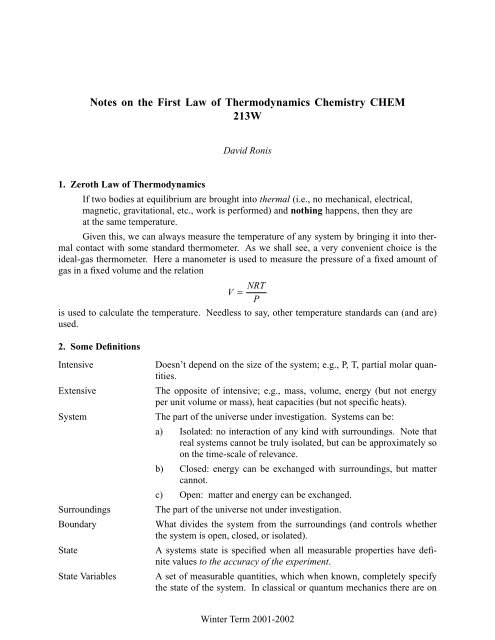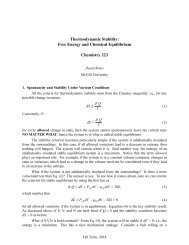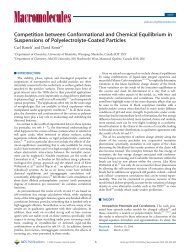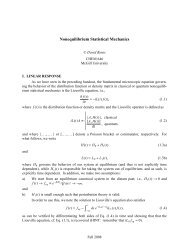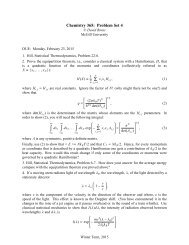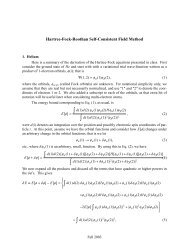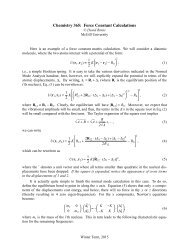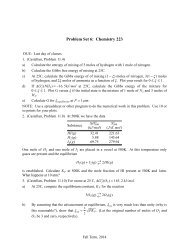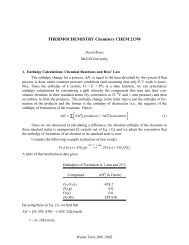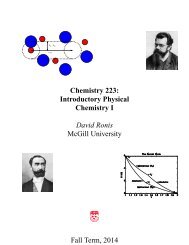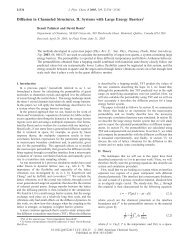Notes on the First Law of Thermodynamics ... - McGill University
Notes on the First Law of Thermodynamics ... - McGill University
Notes on the First Law of Thermodynamics ... - McGill University
Create successful ePaper yourself
Turn your PDF publications into a flip-book with our unique Google optimized e-Paper software.
<str<strong>on</strong>g>Notes</str<strong>on</strong>g> <strong>on</strong> <strong>the</strong> <strong>First</strong> <strong>Law</strong> <strong>of</strong> <strong>Thermodynamics</strong> Chemistry CHEM213WDavid R<strong>on</strong>is1. Zeroth <strong>Law</strong> <strong>of</strong> <strong>Thermodynamics</strong>If two bodies at equilibrium are brought into <strong>the</strong>rmal (i.e., no mechanical, electrical,magnetic, gravitati<strong>on</strong>al, etc., work is performed) and nothing happens, <strong>the</strong>n <strong>the</strong>y areat <strong>the</strong> same temperature.Given this, we can always measure <strong>the</strong> temperature <strong>of</strong> any system by bringing it into <strong>the</strong>rmalc<strong>on</strong>tact with some standard <strong>the</strong>rmometer. Asweshall see, a very c<strong>on</strong>venient choice is <strong>the</strong>ideal-gas <strong>the</strong>rmometer. Here a manometer is used to measure <strong>the</strong> pressure <strong>of</strong> a fixed amount <strong>of</strong>gas inafixed volume and <strong>the</strong> relati<strong>on</strong>V = NRTPis used to calculate <strong>the</strong> temperature. Needless to say, o<strong>the</strong>r temperature standards can (and are)used.2. Some Definiti<strong>on</strong>sIntensiveExtensiveSystemSurroundingsBoundaryStateState VariablesDoesn’t depend <strong>on</strong> <strong>the</strong> size <strong>of</strong> <strong>the</strong> system; e.g., P, T,partial molar quantities.The opposite <strong>of</strong> intensive; e.g., mass, volume, energy (but not energyper unit volume or mass), heat capacities (but not specific heats).The part <strong>of</strong> <strong>the</strong> universe under investigati<strong>on</strong>. Systems can be:a) Isolated: no interacti<strong>on</strong> <strong>of</strong> any kind with surroundings. Note thatreal systems cannot be truly isolated, but can be approximately so<strong>on</strong> <strong>the</strong> time-scale <strong>of</strong> relevance.b) Closed: energy can be exchanged with surroundings, but mattercannot.c) Open: matter and energy can be exchanged.The part <strong>of</strong> <strong>the</strong> universe not under investigati<strong>on</strong>.What divides <strong>the</strong> system from <strong>the</strong> surroundings (and c<strong>on</strong>trols whe<strong>the</strong>r<strong>the</strong> system is open, closed, or isolated).A systems state is specified when all measurable properties have definitevalues to <strong>the</strong> accuracy <strong>of</strong> <strong>the</strong> experiment.A set <strong>of</strong> measurable quantities, which when known, completely specify<strong>the</strong> state <strong>of</strong> <strong>the</strong> system. In classical or quantum mechanics <strong>the</strong>re are <strong>on</strong>Winter Term 2001-2002
<str<strong>on</strong>g>Notes</str<strong>on</strong>g> <strong>on</strong> <strong>the</strong> <strong>First</strong> <strong>Law</strong> -4- Chemistry CHEM 213W⎛ ∂A⎞dT + ⎛ ∂A⎞dP −⎝ ∂T ⎠ P,N1 , ... ,N r⎝ ∂P ⎠Σ rN i d A i = 0 (8)T ,N1 , ... ,N rand hence, <strong>the</strong> changes in <strong>the</strong> partial molar quantities and o<strong>the</strong>r derivatives are not all independent.Equati<strong>on</strong> (8) is known as a Gibbs-Duhem relati<strong>on</strong> and can be used to relate seemingly disparate<strong>the</strong>rmodynamic derivatives.As an exercise, what are <strong>the</strong> partial molar volumes for an ideal gas mixture obeying Dalt<strong>on</strong>’slaw <strong>of</strong> partial pressures? Do <strong>the</strong>y obey <strong>the</strong> Gibbs-Duhem relati<strong>on</strong>?4. Work and Heat in <strong>Thermodynamics</strong>Tw o central c<strong>on</strong>cepts in <strong>the</strong>rmodynamics are work and heat. Youprobably have seenexamples <strong>of</strong> <strong>the</strong> former in your freshman physics class, and <strong>the</strong> latter is something you experiencein daily life. In <strong>the</strong>rmodynamics, both have very precise definiti<strong>on</strong>s.Work:anything which crosses <strong>the</strong> boundary <strong>of</strong> <strong>the</strong> system and is completely c<strong>on</strong>vertibleinto <strong>the</strong> lifting <strong>of</strong> a weight in <strong>the</strong> surroundings.Note that work <strong>on</strong>ly appears at <strong>the</strong> boundary <strong>of</strong> a system, during a change <strong>of</strong> state, isextensive, and is manifested by an effect in <strong>the</strong> surroundings. From mechanics, we know thatdW = Fdx = mgdx,where dW is <strong>the</strong> incremental work d<strong>on</strong>e by <strong>the</strong> system, F is <strong>the</strong> force, and dx is <strong>the</strong> distance traversed.The sec<strong>on</strong>d equality is for moving a mass m a distance dx in a gravitati<strong>on</strong>al field (g is <strong>the</strong>gravitati<strong>on</strong>al accelerati<strong>on</strong> c<strong>on</strong>stant). C<strong>on</strong>sider <strong>the</strong> following apparatus:i=1dxM (mass)A (area)The inside <strong>of</strong> <strong>the</strong> pist<strong>on</strong> is filled with some gas at pressure Pand is maintained at c<strong>on</strong>stant temperature T. Instead <strong>of</strong>characterizing <strong>the</strong> work d<strong>on</strong>e in terms <strong>of</strong> <strong>the</strong> mass, it ismore c<strong>on</strong>venient to introduce <strong>the</strong> pressure exerted <strong>on</strong> <strong>the</strong>top <strong>of</strong> <strong>the</strong> pist<strong>on</strong> (i.e., force per unit area, A)P op ≡ F A = mgA .Note that P op need not equal P.Thusd − W = P op Adx = P op dVwhere dV is <strong>the</strong> incremental change in <strong>the</strong> volume <strong>of</strong> <strong>the</strong> system. The work involved in <strong>the</strong>sesorts <strong>of</strong> processes is known as pressure-volume work.Note that <strong>the</strong> work d<strong>on</strong>e is not astate functi<strong>on</strong>--it depends <strong>on</strong> <strong>the</strong> pressure exerted <strong>on</strong> <strong>the</strong>pist<strong>on</strong> (<strong>the</strong> path) and is not simply a functi<strong>on</strong> <strong>of</strong> <strong>the</strong> state <strong>of</strong> <strong>the</strong> gas in <strong>the</strong> pist<strong>on</strong>. To stress thisfact, <strong>the</strong> notati<strong>on</strong> d − will be used for infinitesimal changes in quantities which depend <strong>on</strong> <strong>the</strong> path.For anprocess whereby <strong>the</strong> gas is expanded against some pressure, dV >0,and hence,d − W >0. C<strong>on</strong>versely, inacompressi<strong>on</strong> process, d − W
<str<strong>on</strong>g>Notes</str<strong>on</strong>g> <strong>on</strong> <strong>the</strong> <strong>First</strong> <strong>Law</strong> -5- Chemistry CHEM 213WThis diagram shows a process for <strong>the</strong> iso<strong>the</strong>rmalexpansi<strong>on</strong> <strong>of</strong> a gas (in this case an ideal gas). The solidcurve gives <strong>the</strong> pressure <strong>of</strong> <strong>the</strong> gas (i.e., its equati<strong>on</strong> <strong>of</strong>state). The dotted curve gives <strong>the</strong> opposing pressure actuallyused in <strong>the</strong> expansi<strong>on</strong>. Note that <strong>the</strong> latter lies completelybelow <strong>the</strong> former. Ifatany point this were not <strong>the</strong>case, <strong>the</strong>n <strong>the</strong> expansi<strong>on</strong> would not proceed sp<strong>on</strong>taneously(i.e., <strong>the</strong> opposing pressure would be too large and <strong>the</strong> gaswould c<strong>on</strong>tract).W =V finalV initialThe total work d<strong>on</strong>e by <strong>the</strong> system is just <strong>the</strong> areaunder <strong>the</strong> dotted curve:∫ P op(V )dV ≤V final∫ P(V )dV ≡ W rev.If <strong>the</strong> gas inside <strong>the</strong> pist<strong>on</strong> is ideal, <strong>the</strong>n <strong>the</strong> ideal-gas equati<strong>on</strong> <strong>of</strong> state is valid andV initialW rev =V final∫V initialNRTV dV = NRT ln(V final/V initial ).Note that <strong>the</strong> maximum work you can get out <strong>of</strong> a sp<strong>on</strong>taneous expansi<strong>on</strong> is obtained when<strong>the</strong> opposing pressure is infinitesimally less than <strong>the</strong> pressure being exerted by <strong>the</strong> gas in <strong>the</strong> pist<strong>on</strong>.In this case, W = W R . Unfortunately, <strong>the</strong> rate <strong>of</strong> such an expansi<strong>on</strong> would be zero, as wouldbe <strong>the</strong> power delivered by <strong>the</strong> system. On <strong>the</strong> o<strong>the</strong>r hand, it is easy to show that <strong>the</strong> path givenby P op = P is <strong>the</strong> <strong>on</strong>ly reversible <strong>on</strong>e for <strong>the</strong> iso<strong>the</strong>rmal expansi<strong>on</strong> <strong>of</strong> an ideal gas.C<strong>on</strong>sider <strong>the</strong> following apparatus (from L. K. Nash, Elements <strong>of</strong> Chemical <strong>Thermodynamics</strong>,Addis<strong>on</strong>-Wesley, 1970):The spring is assumed to obey Hooke’s law (i.e, <strong>the</strong> force is proporti<strong>on</strong>al to <strong>the</strong> el<strong>on</strong>gati<strong>on</strong>). AWinter Term 2001-2002
<str<strong>on</strong>g>Notes</str<strong>on</strong>g> <strong>on</strong> <strong>the</strong> <strong>First</strong> <strong>Law</strong> -6- Chemistry CHEM 213Wseries <strong>of</strong> experiments are performed whereby weights are moved topan from platforms at variousheights in <strong>the</strong> surroundings. In doing so, <strong>the</strong> system (<strong>the</strong> spring and pan) move from state I to II.How much work is performed in each <strong>of</strong> <strong>the</strong> cases (a)−(c) (assume that <strong>the</strong>re is a total 1cm el<strong>on</strong>gati<strong>on</strong><strong>of</strong> <strong>the</strong> spring and ignore <strong>the</strong> mass <strong>of</strong> <strong>the</strong> pan and spring)?In order to reverse <strong>the</strong> process (i.e., <strong>the</strong> expansi<strong>on</strong> <strong>of</strong> <strong>the</strong> spring) <strong>the</strong> weights are movedback to <strong>the</strong> adjacent platforms. However, it iseasy to see that while <strong>the</strong> spring will be fully compressedat <strong>the</strong> end <strong>of</strong> <strong>the</strong> experiment, <strong>the</strong> surroundings will not be restored to <strong>the</strong>ir initial state;specifically, in<strong>the</strong> best case, <strong>the</strong> topmost weight will be transferred to <strong>the</strong> lowest platform, nomatter how many platforms are used. Clearly <strong>the</strong> biggest change in <strong>the</strong> surroundings will happenin case (a) and <strong>the</strong> smallest in (c). Moreover, <strong>the</strong> smaller <strong>the</strong> individual weights we use, <strong>the</strong> morereversible <strong>the</strong> process becomes (i.e., <strong>the</strong> change to <strong>the</strong> surroundings decreases). The process isreversible in <strong>the</strong> limit where <strong>the</strong> applied force (<strong>the</strong> weight) is <strong>on</strong>ly infinitesimally more than <strong>the</strong>force exerted by <strong>the</strong> spring.This argument can easily be extended to our discussi<strong>on</strong> <strong>of</strong> pressure-volume work or too<strong>the</strong>r kinds <strong>of</strong> work. Hence, <strong>the</strong> maximum work in a P-V expansi<strong>on</strong> is obtained for a reversiblepath.Heat:Ano<strong>the</strong>r key quantity in <strong>the</strong>rmodynamics is heat.Anything which flows across <strong>the</strong> boundary <strong>of</strong> a system by virtue <strong>of</strong> a temperaturedifference between <strong>the</strong> system and <strong>the</strong> surroundings.Heat is quantified by measuring <strong>the</strong> temperature rise (or fall) in a standard material (e.g., acalorie corresp<strong>on</strong>ds to <strong>the</strong> amount <strong>of</strong> heat required to raise <strong>the</strong> temperature <strong>of</strong> 1 g <strong>of</strong> water 1 o C).Like work, heat appears <strong>on</strong>ly at <strong>the</strong> boundary <strong>of</strong> a system, during a change <strong>of</strong> state, is extensive,and is manifested by an effect in <strong>the</strong> surroundings. It is also not a state functi<strong>on</strong> since it depends<strong>on</strong> <strong>the</strong> nature <strong>of</strong> <strong>the</strong> <strong>the</strong>rmal c<strong>on</strong>tact allowed at <strong>the</strong> boundary <strong>of</strong> <strong>the</strong> system.In a classic set <strong>of</strong> experiments in <strong>the</strong> 19’th century, J.P.Joule showed that <strong>the</strong> samechanges in <strong>the</strong> state <strong>of</strong> a system could be achieved byei<strong>the</strong>r adding work or heat to <strong>the</strong> system.One <strong>of</strong> his devices is shown below.As <strong>the</strong> weight falls, <strong>the</strong> paddles turn andheat up <strong>the</strong> liquid in <strong>the</strong> c<strong>on</strong>tainer by fricti<strong>on</strong>(viscous heating). The same temperaturerise can be achieved bydirectly heating <strong>the</strong>c<strong>on</strong>tainer using a known amount <strong>of</strong> heat.1 calorie = 4. 184 kg m 2 /sec 2 .The amounts <strong>of</strong> heat and work weredefinite and Joule c<strong>on</strong>cluded that work andheat were simply two different ways inwhich energy could be added to a system.Specifically, Joule showed thatWe are now ready to state <strong>the</strong> first law <strong>of</strong><strong>the</strong>rmodynamics. Before doing so, it is illustrativeto c<strong>on</strong>sider energy in classical mechanics.Winter Term 2001-2002
<str<strong>on</strong>g>Notes</str<strong>on</strong>g> <strong>on</strong> <strong>the</strong> <strong>First</strong> <strong>Law</strong> -7- Chemistry CHEM 213W5. Energy in Classical MechanicsYouprobably have heard <strong>the</strong> statement that "energy is c<strong>on</strong>served." What does this meanexactly? C<strong>on</strong>sider asystem comprised <strong>of</strong> N point particles <strong>of</strong> mass m, atpositi<strong>on</strong>s r → 1 , ... , r → N ,andmoving with velocities v → 1 , ... →v N . The system is not subjected to any external forces. In additi<strong>on</strong>,assume that Newt<strong>on</strong>’s laws <strong>of</strong>moti<strong>on</strong> are valid and that <strong>the</strong> particles interact via pairwise additiveforces which are derivable from a potential; i.e., <strong>the</strong> force particle i exerts <strong>on</strong> j, F → i, j is givenbyC<strong>on</strong>sider <strong>the</strong> energy functi<strong>on</strong>, E, defined asE ≡ Σ N m 2i=1→F i, j ≡− ∂u i, j.∂r → i→v 2 i + 1 2NΣ Ni=1 j=1i≠ jΣ u i, j .How does E change as <strong>the</strong> particles move around under <strong>the</strong> acti<strong>on</strong> <strong>of</strong> Newt<strong>on</strong>’s <strong>Law</strong>s?dEdt= NΣ m → v i ⋅ → F i − 1 2i=1NΣ Ni=1 j=1i≠ jΣ → F i, j ⋅ ( → v i − → v j ),where F → i ≡ Σ F → i, j is <strong>the</strong> total force acting <strong>on</strong> <strong>the</strong> i’th particle. Using this definiti<strong>on</strong> <strong>of</strong> F → i in ourj≠iexpressi<strong>on</strong> for <strong>the</strong> rate <strong>of</strong> change <strong>of</strong> E gives:dEdt= 1 2= 1 2NΣ Ni=1 j=1i≠ jNΣ Ni=1 j=1i≠ jΣ → F i, j ⋅ ( → v i + → v j )Σ( → F i, j + → F j,i ) ⋅ → v iwhere <strong>the</strong> dummy summati<strong>on</strong> indices, i and j, were exchanged for <strong>the</strong> terms in → v j in obtaining<strong>the</strong> last equality. Newt<strong>on</strong>’s third law states that → F i, j =− → F j,i ;i.e., <strong>the</strong> force i exerts <strong>on</strong> j is equaland opposite to that j exerts <strong>on</strong> i. Using this in our last expressi<strong>on</strong> immediately shows thatdE= 0.dtIn o<strong>the</strong>r words, <strong>the</strong> energy <strong>of</strong> our classical system <strong>of</strong> particles doesn’t change in time or is c<strong>on</strong>served.The same is true under <strong>the</strong> laws <strong>of</strong> quantum mechanics. What happens if, in additi<strong>on</strong> to<strong>the</strong> forces acting between <strong>the</strong> particles, <strong>the</strong> particles are subjected to an external forces?The first law <strong>of</strong><strong>the</strong>rmodynamics also has something to say about changes in energy,although not in precisely <strong>the</strong> same way as in classical or quantum mechanics6. The <strong>First</strong> <strong>Law</strong> <strong>of</strong> <strong>Thermodynamics</strong>:In any cyclic process (i.e., <strong>on</strong>e where <strong>the</strong> system returns to its initial state) <strong>the</strong>net heat absorbed by <strong>the</strong> system is equal to <strong>the</strong> work produced by <strong>the</strong> system.Winter Term 2001-2002
<str<strong>on</strong>g>Notes</str<strong>on</strong>g> <strong>on</strong> <strong>the</strong> <strong>First</strong> <strong>Law</strong> -8- Chemistry CHEM 213WSuppose this were not <strong>the</strong> case. Then you could presumably find a process which producedmore work than it absorbed heat. This extra work could be used to run a generator, whichin turn could be used to produce more heat, which could run more <strong>of</strong> process, producing evenmore excess work, and so <strong>on</strong>. The energy crisis, electric bills, etc. would be things <strong>of</strong> <strong>the</strong> past.Unfortunately, nosuch device has ever been built and <strong>the</strong> first law still stands.In ma<strong>the</strong>matical terms, <strong>the</strong> first law implies that <strong>the</strong>re is a state functi<strong>on</strong>, called <strong>the</strong> internalenergy <strong>of</strong> <strong>the</strong> system, defined up to an arbitrary additive c<strong>on</strong>stant through its differentialdE ≡ d − Q − d − W,where d − W is <strong>the</strong> work d<strong>on</strong>e by <strong>the</strong> system (<strong>the</strong> negative <strong>of</strong> <strong>the</strong> work d<strong>on</strong>e <strong>on</strong> <strong>the</strong> system). For afinite change <strong>of</strong> state, <strong>the</strong> change in <strong>the</strong> internal energy, ∆E, isgiven byThe first law states that∆E =final state∫d − Q − d − W.initial state∫ odE = ∫ od− Q −∫ od− W = 0.The first law implies that <strong>the</strong> energy change computed al<strong>on</strong>g different paths must give <strong>the</strong>same answer. Ifnot, two such paths could be used to to build <strong>the</strong> energy-creating device discussedabove (i.e., by reversing <strong>on</strong>e <strong>of</strong> <strong>the</strong> paths).Winter Term 2001-2002


